There seems to be so much harping about my departure from the International Code of Botanical Nomenclature (ICBN) that I obviously need to try and explain myself better. The real issue is that we are dealing with a group of plants that is largely appreciated for its vegetative characters and not for its small and unexceptional flowers. Because the plants are small and so commonly grown by collectors the numbers of plants in cultivation and close observation is large. The plants also do vary in respect of leaf morphology, arrangement, and surfaces to a greater extent than in many other genera. Furthermore, the variation is also exaggerated by growing conditions. The fact that flowers are not used in the classification process beyond the level of sub-genera means that there is an almost total reliance on vegetative characters for classification. The nomenclatural system in botany tends to be a typological one, which means that reliance is placed on descriptions very often derived from single specimens. This is particularly so when the nomenclatural types are simply old illustrations that have been used to arrive at identifications and names by consecutive authors for decades. Thus use of those identifications and names, and their continuing re-interpretation causes a great deal of either grief or great personal satisfaction depending on just who is being affected by the process. The fact that the names should indicate “species” is lost from sight and totally obscured by the additional absence of any good universally accepted explanation for what a species is or might be.
Explanation in and around all this has been a large part of my writing since I started this in 1962. Thus I will not enlarge on the subject but rather try to explain again this way using a species name generated by Col. C.L. Scott with whom I had some considerable altercation. It must be understood that Col. Scott was not a biologist and it is just a simple fact that the problems that the above brief remarks expose, trouble many professional taxonomists to this day. I do not condemn Col. Scott and express my respect and admiration for him and am very grateful to him for the friendship he later extended to me before he died.
The example I will take is that of his species Haworthia geraldii. It comes from a small hillside east of Riversdale running south to north, named Komserante. This is an Afrikaans term meaning the ridge around a small geographic basin. In the way that haworthias are assembled in small habitat defined and localised populations, there are three recognizable populations of plants (of the subgenus Haworthia) along this one ridge about 1km long. The southern population used to be complemented by still another that occurred where the stream bed left the basin at the southern end. A plant from that southern population was named as H. foucheii by K. von Poellnitz. The northern population is a bit problematic and I initially included it in my then concept of H. magnifica. Since then however, it has become clear to me that my idea of species was too conservative and that H. magnifica as described by von Poellnitz from south east of Riversdale (now the Frehse Reserve) is part and parcel of a huge complex that I regard as H. mirabilis. Thus this northern population is seen by me as H. mirabilis but complicated by the fact that it is largely influenced by hybridization with the next population or populations south. A plant (or perhaps, and doubtfully, plants) have been given the name H. vernalis by the Japanese writer M Hayashi. The name H. geraldii is attached to the second population southwards. The plants are very proliferous, form large clumps and the leaves are usually quite strongly retused (“bent back like a thumb”). The name H. foucheii is simply attached to the third because the plants there tend to be solitary and the leaves are also fairly erect and spreading as described and pictured for the original from the fourth population that was off the ridge.
The problem is now that we have descriptions and plants in each population that do not match the descriptions. While I assign the northern population and all the plants in it to H. mirabilis, other writers use the names H. vernalis, H. magnifica and even the confused name H. asperula. What they mean is by no means clear and in actuality a lot more names and descriptions would then be required to name each of the countless variants there for what might be an original pure species and variants or for first second or third generation hybrids with H. geraldii or H. foucheii as those names were applied.
But the problem is far more extensive than just these four populations. After years and years of field exploration it has become evident to me that like H. mirabilis, H. retusa is also highly diverse and I see it to include all the variants of H. turgida. In fact I suggested a long time ago that H. retusa is simply the solitary large form of H. turgida in low-lying level areas as opposed to the more common and extensive clumping cliff dwelling forms of that species. This is also why I object to the requirements of the ICBN that require the name H. retusa to take precedence for the species for historical reasons when it would be far more realistic to take it as a variant of H. turgida for biological reasons.
It has always been simply evident to me that H. geraldii and H. foucheii are variants of H. retusa. The problem now is that the plants in the two populations vary so much that, while the names are indeed useful for commercial and collector use, there can be problems that the use and application of the names will be confused.
Look at it like this. In respect of H. geraldii; it came from one population at Komserante, Riversdale and not all the plants are the same. I think this one population and all those plants in it belong to the species H. retusa, so I called it H. retusa var. geraldii. (var. = variety). Because not all the plants look the same that means that only some are truly geraldii and only the plants that meet Scott’s description are actually var. geraldii. Because the plants multiply vegetatively and Scott only took a piece, the original plant may still be there. This means that we should recognize it as H. retusa var. geraldii forma geraldii and in cultivation as H. retusa ‘Geraldii’ or just as H. ‘Geraldii’. What do we do with the other 100 plants or more in the population that are not H. retusa ‘Geraldii’? I do not think they can all get names so I take away the capital letter, leave out “var.” and use ‘and’ (inverted commas) to show that the identification is, and will, be a bit uncertain unless you know from a label that the plant comes from that particular population at Komserante. The same applies to H. retusa var. foucheii. In this case the original population is gone and I am not sure if H. ‘Foucheii’ is still in cultivation. So I use the name H. retusa ‘foucheii’ for a second population on Komserante. Some of the plants in this population look like some of those in the H. retusa ‘geraldii’ population but not quite like H. ‘Geraldii’ itself. So for me the answer is MBB7780 H. retusa ‘geraldii’, Komserante and MBB7781 H retusa ‘foucheii’, Komserante.
It can be seen that a complication comes in when more than one population is involved. The problem then is that you can put them in a line so that some plants in the first population look like plants in the second, some in the second look like plants in the third, some of those look like those in the fourth until at the end none of the plants in the last population look like any in the first. The trouble in the field is that the line is not straight and it can also go off in different directions. Some of those directions may end up where they started. One simply cannot be truly confident about many of those names that are given to plants. Serious and proper consideration must be given for how different they may be even within the populations. Not to say of the shared similarities and still added variation from geographically adjacent populations. It may happen that I may write H. ‘retusa’ (and add number and place name) for a population that may better (not necessarily correctly) be identified as H. retusaXmirabilis. Other writers who are not biologists and have other considerations in mind may want to give a new name altogether. That new name and description may be again really only for one plant, or maybe a few more in a population, that have real or imagined novelty value and attraction. But they take no account of all of the less attractive variants or other populations that comprise the biological whole by close proximity if for nothing else.
The above discussion is integral to the rationalized list of names that Dr John Manning helped me produce. There are some species names there that I have deliberately presented as synonyms or variants of the species I recognize, because the authors of those names fail to convince me that they have any understanding of the situation at all. The word “species” is apparently simply a convenient naming system for oddities and novelties and not any scientific construct to explain the natural phenomena of living systems and their parts.
To summarize; I have written a report on flower characters in which I refer to the Komserante populations and I have used the following names and my own convention as follows:-
Please note that the way I have omitted the word variety from the following names and also used inverted commas …
7779 H. mirabilis, Komserante (the northern population – I could add ‘vernalis’ but it carries all the baggage of doubt about actual status).
7780 H. retusa ‘geraldii’, Komserante.
7781 H. retusa ‘foucheii’, Komserante.
7920 H. retusa ‘nigra’, Van Reenens Crest.
The omission of the word variety is for two reasons…
1. Economy
2. To convey the idea that the actual indication of status is not certain as I have used the name to indicate a population or populations rather than a single described plant. The prime and overriding uncertainty is that we cannot know what a species is that I have described for Haworthia. Thus how can we possibly rank populations at levels below?
The use of inverted commas reinforces what I want to convey. This is that the individual plants in the populations are variable and it may not be easy to always identify the plants (individual or population) according to a more formal classification.
Any departure from the ICBN or the way the names are treated in formal botany conveys the difficulty that I personally find in trying to reconcile formal nomenclature with names that are so often tied to single plants.

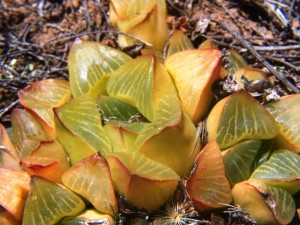
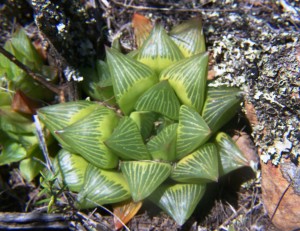
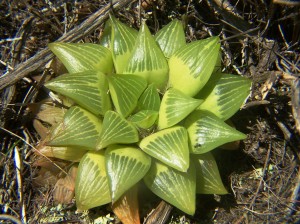

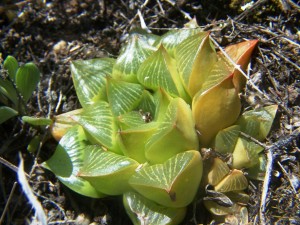
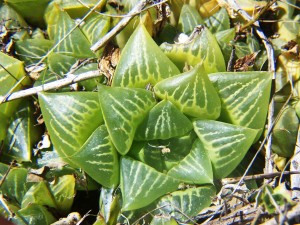
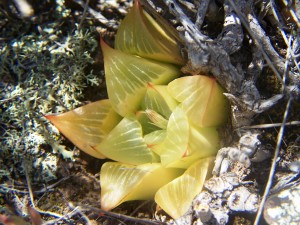
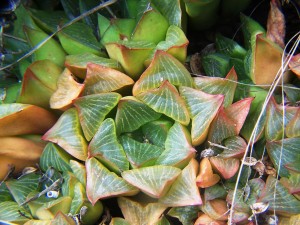
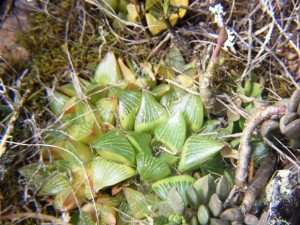
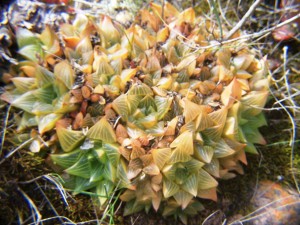
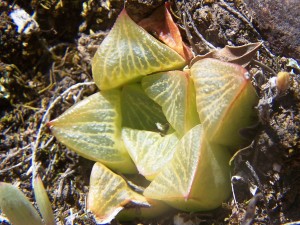
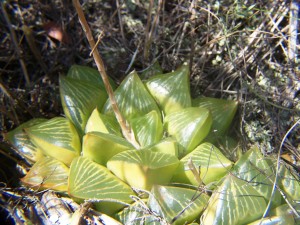

♦

Pingback: Still another view of Haworthia retusa and Haworthia mirabilis - Haworthia Updates